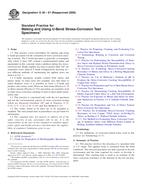Potrebujeme váš súhlas na využitie jednotlivých dát, aby sa vám okrem iného mohli ukazovať informácie týkajúce sa vašich záujmov. Súhlas udelíte kliknutím na tlačidlo „OK“.
ASTM G30-97(2009)
Standard Practice for Making and Using U-Bend Stress-Corrosion Test Specimens
Automaticky preložený názov:
Štandardná prax pre výrobu a použitie U-Bend stresu korózii skúšobné vzorky
NORMA vydaná dňa 1.5.2009
Informácie o norme:
Označenie normy: ASTM G30-97(2009)
Poznámka: NEPLATNÁ
Dátum vydania normy: 1.5.2009
Kód tovaru: NS-57635
Počet strán: 7
Približná hmotnosť: 21 g (0.05 libier)
Krajina: Americká technická norma
Kategória: Technické normy ASTM
Anotácia textu normy ASTM G30-97(2009) :
Keywords:
plastic strain, stress-corrosion cracking, stress-corrosion test specimen, U-bends, Corrosion--stress-corrosion, Inspection, Plastic strains, Specimen preparation (for testing)--corrosion testing, Stress corrosion, Stress corrosion cracking (SCC), Stress corrosion test specimens, U-bend specimens, Visual examination--metals/alloys, ICS Number Code 77.060 (Corrosion of metals)
Doplňujúce informácie
| Significance and Use | ||||||||||||||||||||||||
|
The U-bend specimen may be used for any metal alloy sufficiently ductile to be formed into the U-shape without mechanically cracking. The specimen is most easily made from strip or sheet but can be machined from plate, bar, castings, or weldments; wire specimens may be used also. Since the U-bend usually contains large amounts of elastic and plastic strain, it provides one of the most severe tests available for smooth (as opposed to notched or precracked) stress-corrosion test specimens. The stress conditions are not usually known and a wide range of stresses exist in a single stressed specimen. The specimen is therefore unsuitable for studying the effects of different applied stresses on stress-corrosion cracking or for studying variables which have only a minor effect on cracking. The advantage of the U-bend specimen is that it is simple and economical to make and use. It is most useful for detecting large differences between the stress-corrosion cracking resistance of (a) different metals in the same environment, (b) one metal in different metallurgical conditions in the same environment, or (c) one metal in several environments. |
||||||||||||||||||||||||
| 1. Scope | ||||||||||||||||||||||||
|
1.1 This practice covers procedures for making and using U-bend specimens for the evaluation of stress-corrosion cracking in metals. The U-bend specimen is generally a rectangular strip which is bent 180° around a predetermined radius and maintained in this constant strain condition during the stress-corrosion test. Bends slightly less than or greater than 180° are sometimes used. Typical U-bend configurations showing several different methods of maintaining the applied stress are shown in Fig. 1. 1.2 U-bend specimens usually contain both elastic and plastic strain. In some cases (for example, very thin sheet or small diameter wire) it is possible to form a U-bend and produce only elastic strain. However, bent-beam (Practice G 39 or direct tension (Practice G 49)) specimens are normally used to study stress-corrosion cracking of strip or sheet under elastic strain only. 1.3 This practice is concerned only with the test specimen and not the environmental aspects of stress-corrosion testing which are discussed elsewhere (1) and in Practices G 35, G 36, G 37, G 41, G 44, G 103 and Test Method G 123. 1.4 The values stated in SI units are to be regarded as standard. The inch-pound units in parentheses are provided for information. 1.5 This standard does not purport to address all of the safety concerns, if any, associated with its use. It is the responsibility of the user of this standard to establish appropriate safety and health practices and determine the applicability of regulatory limitations prior to use.
|
||||||||||||||||||||||||
| 2. Referenced Documents | ||||||||||||||||||||||||
|




 Cookies
Cookies
